Two is usually always better than one. Why have one when two are twice as nice?
This is an idea that plays to our basic instincts as a great ape. The prospect of getting not one, but two of something you want is a temptation that even the strongest willed among us struggles with.
Even the word “single” has developed a perilous connotation for modern relationship dynamics. Being single is awesome for a bit, but society and our biology generally (or eventually) motivates us to form a couple.
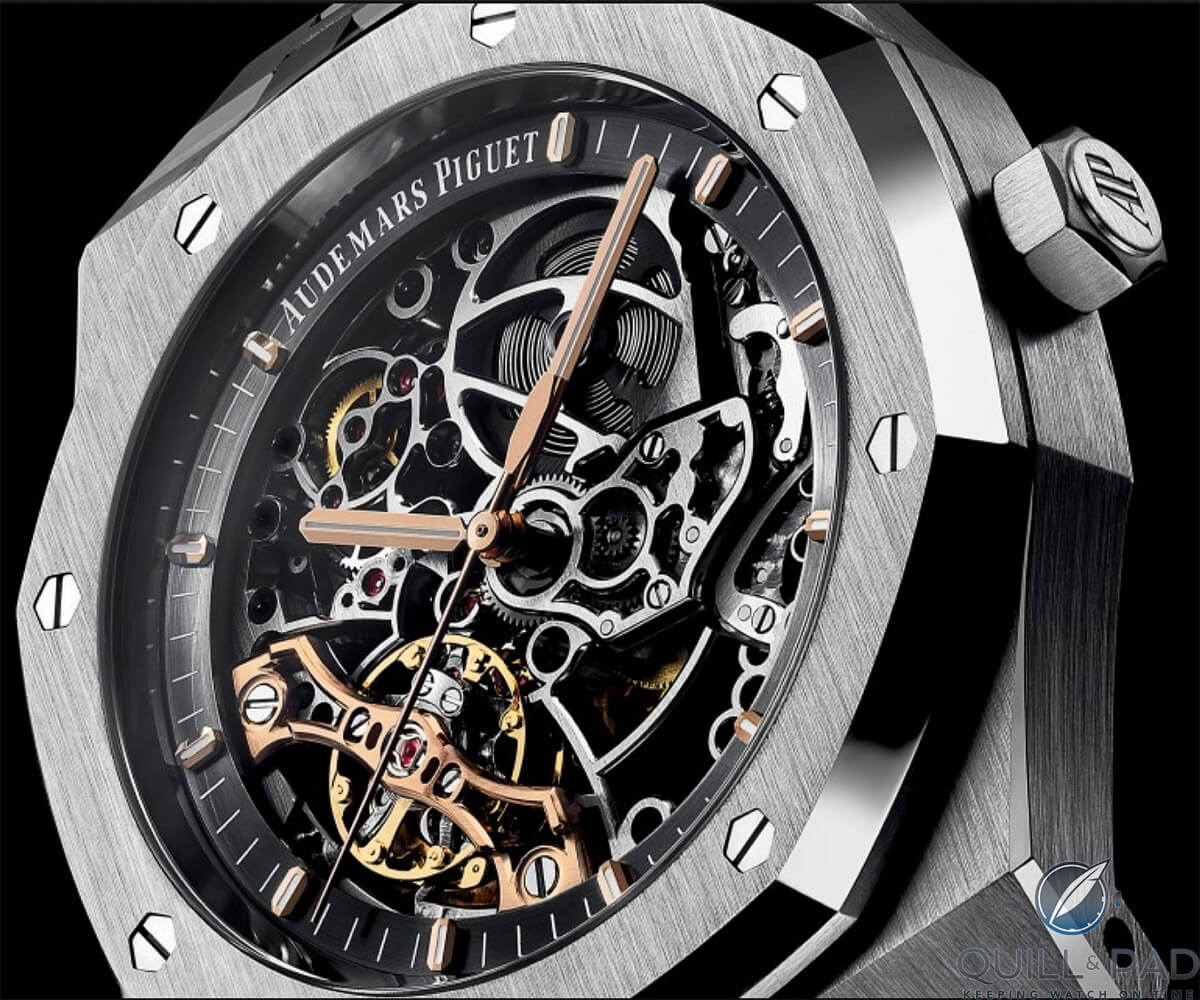
Audemars Piguet Royal Oak Double Balance Wheel Openworked in stainless steel
Advertisers have realized the pull of two over one as well. Just think about it: buy one, get one free; two for the price of one; free bonus item with purchase. It’s all the same. It’s built into a human, one who is a logical being still largely driven by emotion with the ironic ability to rationalize our primal emotional responses.
This is why one gum company has had the same basic marketing strategy since 1939. Doublemint gum has used more than a dozen sets of twins to emphasize that if you want to double your pleasure and double your fun, you can achieve that by chewing on some Doublemint gum. Though there was no scientific backing to the claims, it still proved to work on consumers for the last 70-odd years, meaning that two mints apparently really are better than one.
So if you can have two of something, and the result is clearly better, why would you want it any other way?
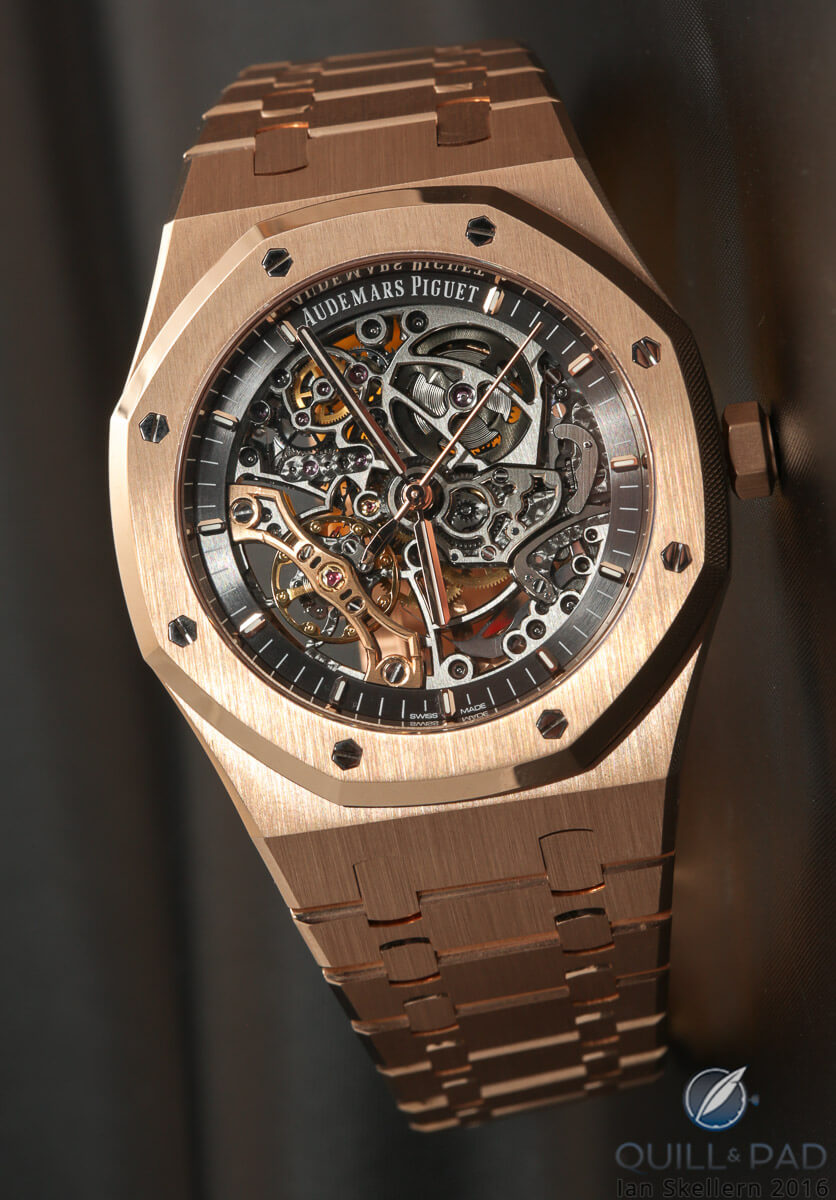
Audemars Piguet Royal Oak Double Balance Wheel Openworked in pink gold
That is a thought pondered again by Audemars Piguet with the release of its new Royal Oak Double Balance Openworked. This new mechanical marvel takes a path that has only recently started to be well traveled, that of a twin-balance wristwatch, and then strays off to do its own thing yet again.
Double balance, not technically a new thing
The idea of using two balances in a watch movement has been around for a while. In the modern era we actually have a good variety of amazing watches to choose from made by watchmakers such as Arnold & Son, Rudis Sylva, MB&F, Greubel Forsey, F.P. Journe, and the legendary Philippe Dufour with his Duality.
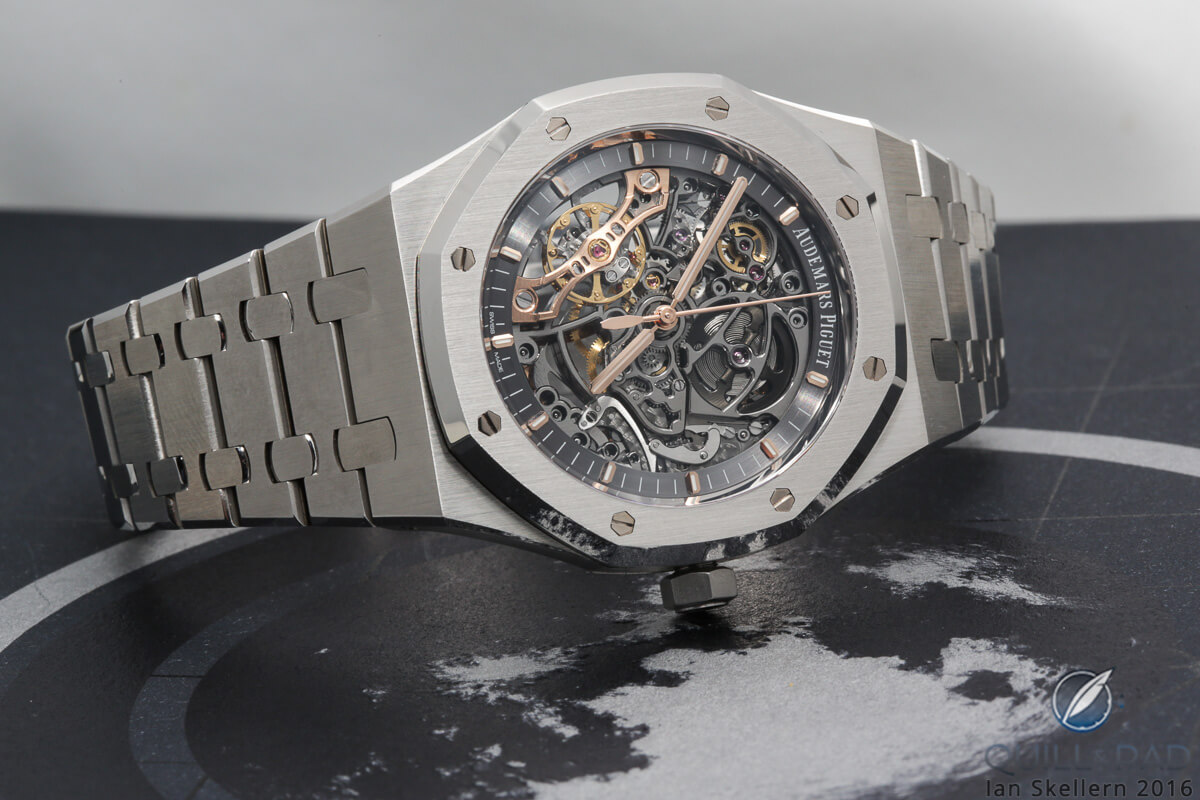
Audemars Piguet Royal Oak Double Balance Wheel Openworked in stainless steel
The concepts behind these pieces vary, but usually result in similar goals of averaging out errors to create a more consistent rate.
This is more “commonly” done via a differential between the two escapements, but sometimes there are two separate gear trains powered by the same mainspring. This setup allows for two independent time mechanisms while still benefiting from a (somewhat reduced) averaging of the rates of the balances. The F.P. Journe Chronomètre à Resonance relies on a different principle, namely mechanical resonance, to provide a stable rate.
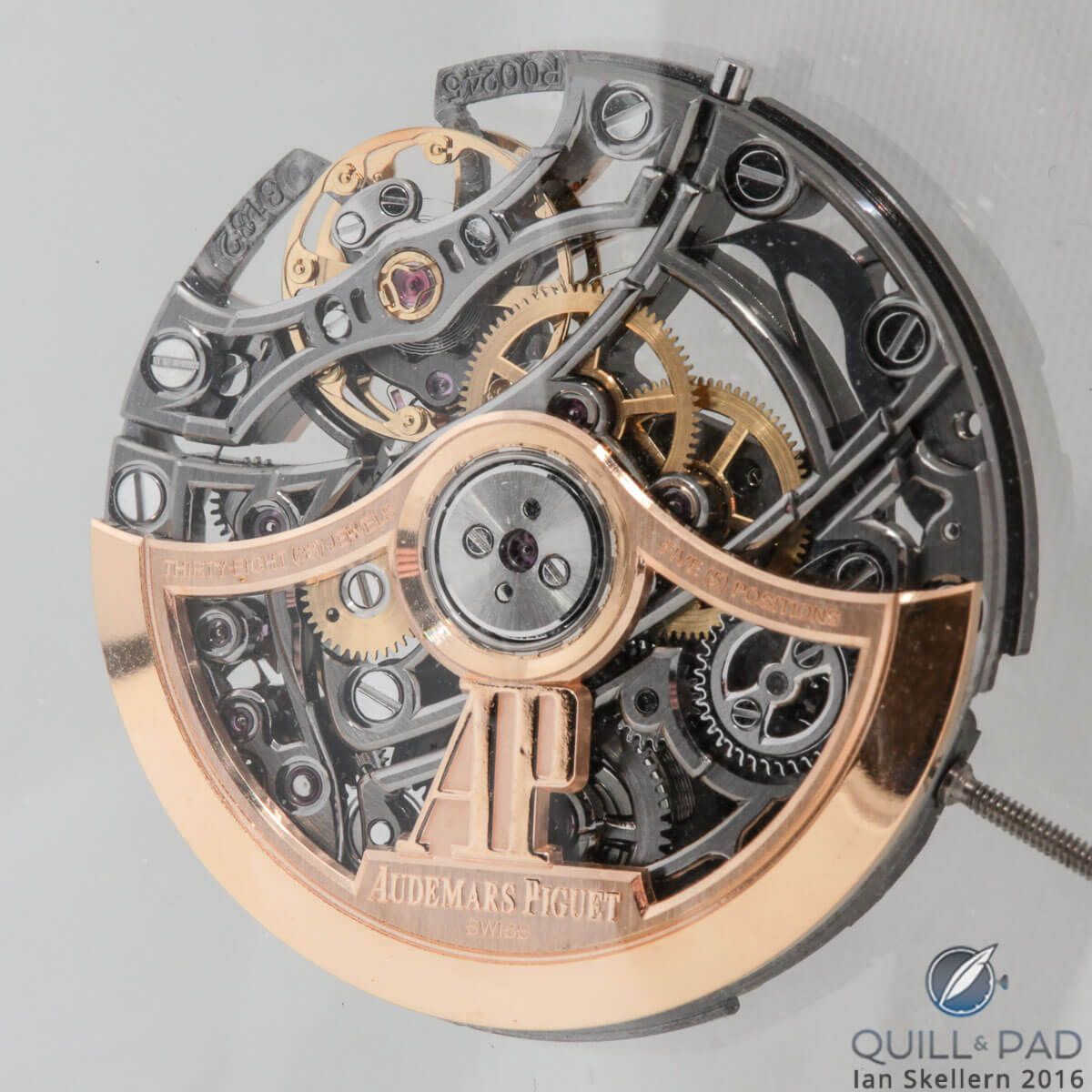
Audemars Piguet Caliber 3132 automatic with double balance wheel
But adding a second balance is not the only way to try and achieve a more stable rate. Another way this has been done is by adding rotational inertia to a single balance. To do this you can make it heavier and/or give it a bigger diameter, or make it lighter and give it a much faster period of oscillation. The first method results in large balance wheels moving slowly, where the mass makes them less susceptible to being disrupted. The most extreme example of this is Antoine Martin’s Slow Runner with its massive 24 mm balance wheel (see The Slowest Watch In The World).
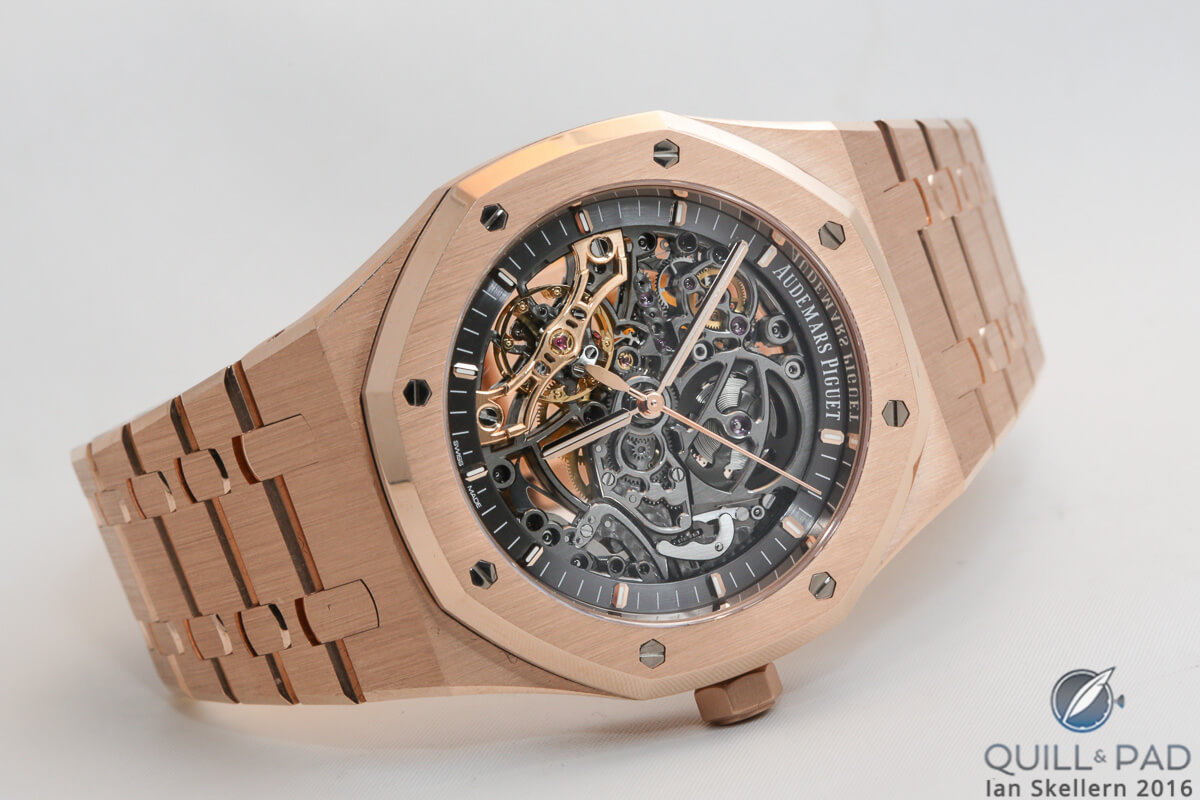
Audemars Piguet Royal Oak Double Balance Wheel Openworked in pink gold
Going in the other direction, though, and making a balance wheel small, light, and very fast provides the ability to average out errors on a smaller scale while the balance beats much faster, making it quickly able to recover from shocks. This has been accomplished in many instances with the frequency increased upwards of 10 to 16 Hz (which is really, really fast).
Another way that has been accomplished is with a double hairspring attached to a single balance wheel. This is where you’ll start to see how it’s all coming back around.
A new path for Audemars Piguet
Audemars Piguet strays from the “established” avenues for tinkering with a balance to make it more stable and consistent in its rate. That’s because the brand did everything I mentioned previously but using almost entirely different methods.
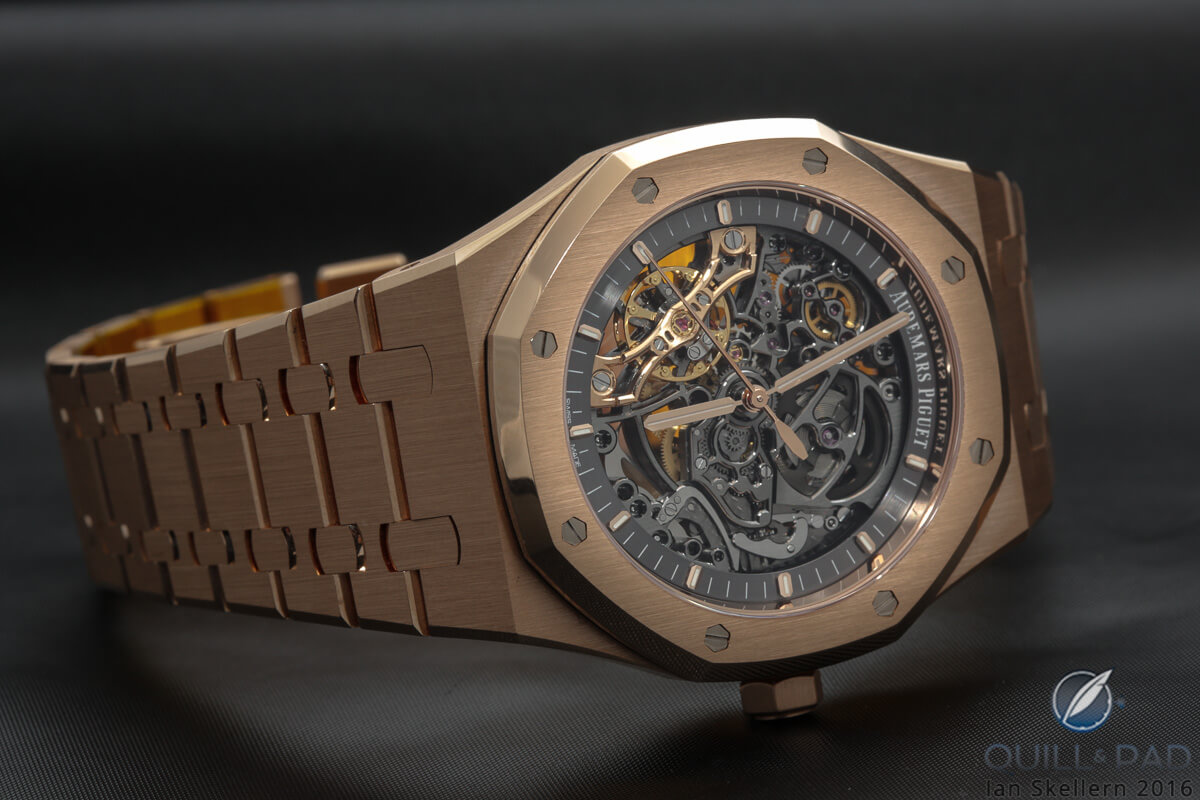
Audemars Piguet Royal Oak Double Balance Wheel Openworked in pink gold
The first, and probably most glaring fact is that the Royal Oak Double Balance features, as you may have guessed, two balance wheels. But these balance wheels also happen to be sharing the same axis of rotation, and what’s more, the exact same balance staff.
This assembly comprises a double-ended balance with wheels on both sides of the movement sharing one pivoting axle. There are no twin balances in this watch, only one bi-wheeled balance assembly. This means it doesn’t require a differential to tie them together and average out their rates, and no resonance will come into effect because there is only one rate for the two balance wheels. That fact does, however, enable the balance assembly to take advantage of some other functions of physics.
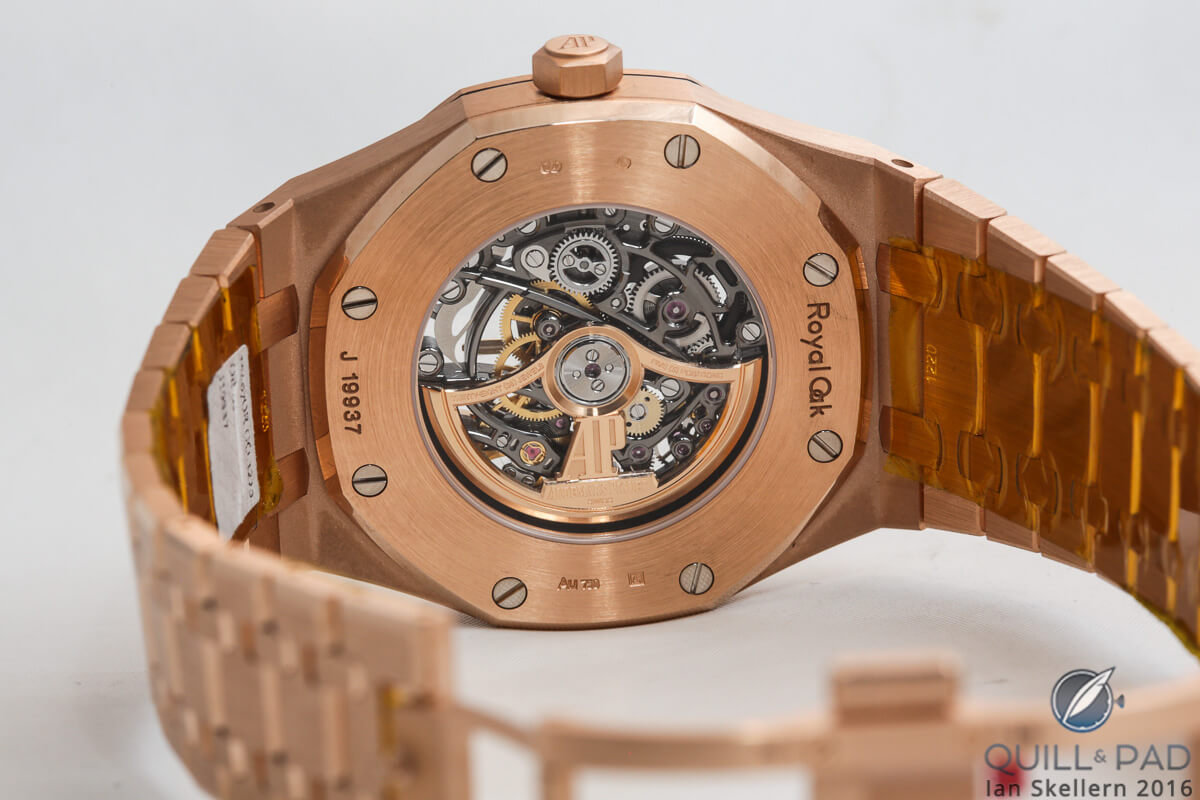
View from the back of the Audemars Piguet Royal Oak Double Balance Wheel Openworked in pink gold
Working with the rotational inertia is where it’s at. First we have the mass of two balances spinning much closer to the central axis than a proportional balance wheel would be if the mass and relative dimensions were maintained. This means it has the benefits of both the increased mass and faster rotational speed from two different schools of thought (though the speed is still kept rather slow in this case).
See? Two is better than one.
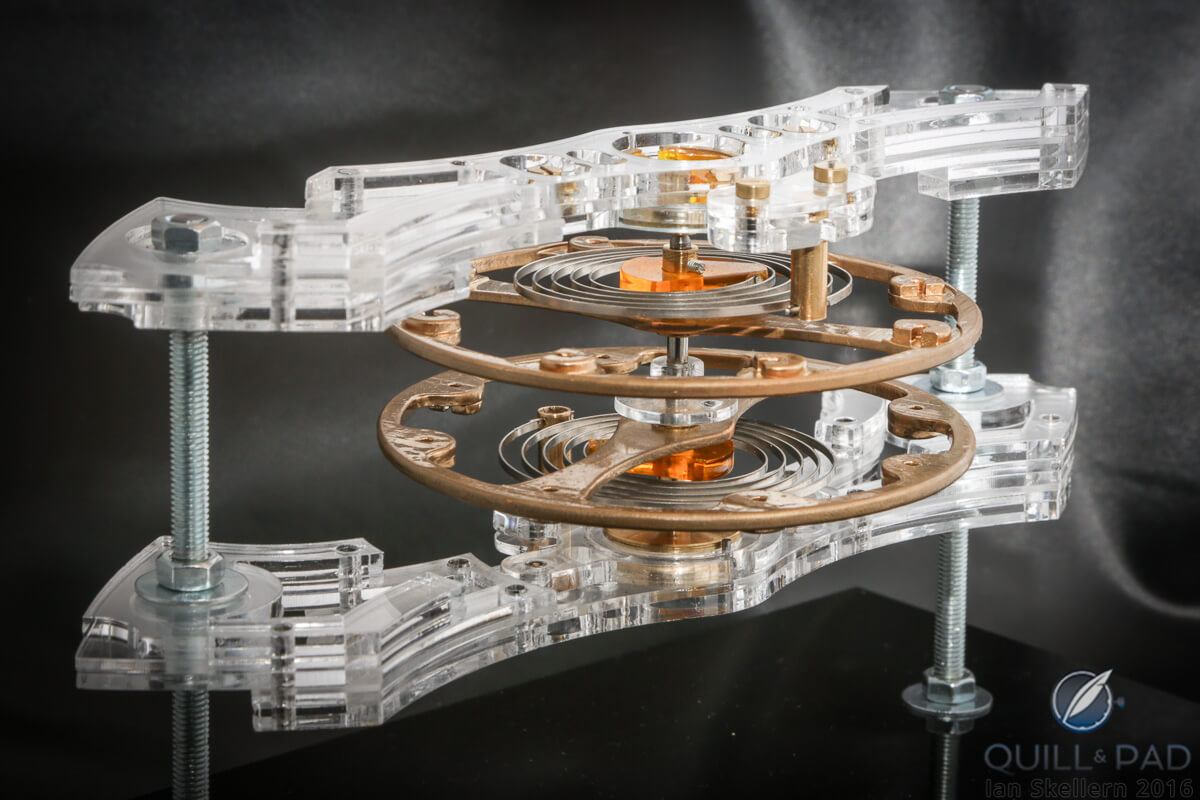
Proof-of-concept model of Audemars Piguet’s double balance wheel
The increased mass makes the rotation much more stable than a lighter balance wheel. And since the wheels are relatively wide apart, you actually have two competing rotating masses that sort of react as a column, creating a pair that is much less likely to be manipulated by shocks than a single rotating disk. This will aid in maintaining a stable and consistent rate.
And the double hairspring?
The double hairspring is the last of the additions that builds toward the goal of a stabler rate. When a hairspring contracts during rotation, it always contracts unevenly, shifting its own center of rotation slightly and pushing the balance staff to the side. This has historically been an issue that different terminal curves have sought to reduce since that side force increases friction between the staff and the pivot jewel, thus slowing the balance (differently, depending on position) and increasing wear.
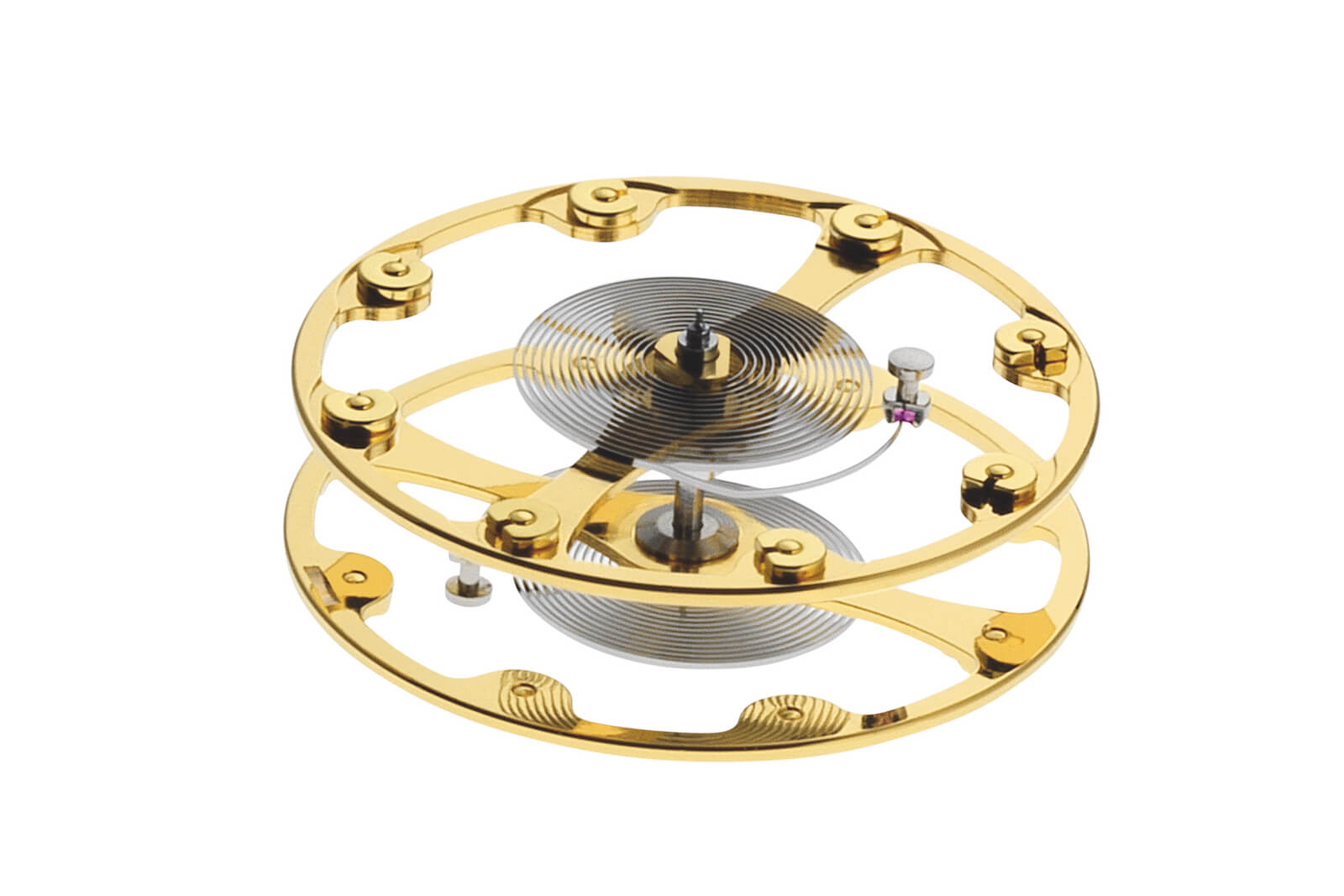
Double balance wheel by Audemars Piguet
Introducing a second hairspring mounted oppositely averages out that sideways force, keeping the balance centered more consistently regardless of position.
If the balance assembly was the only major feature of this watch, it would be amazing. But this watch also happens to feature the increditastic handwork that goes into every openworked Audemars Piguet watch. The somewhat modern take on skeletonization taken by the brand is only emphasized by the exceptional skill that is put into the finishing of the movement components.
The amount of steps it takes to achieve the perfectly beveled edges (including the ever-difficult internal angles) is displayed in full view for the enthusiast in all of us. As a person who makes things on a daily basis with with the tediousness of hand-finishing, I find watching it to be a zen-like activity.
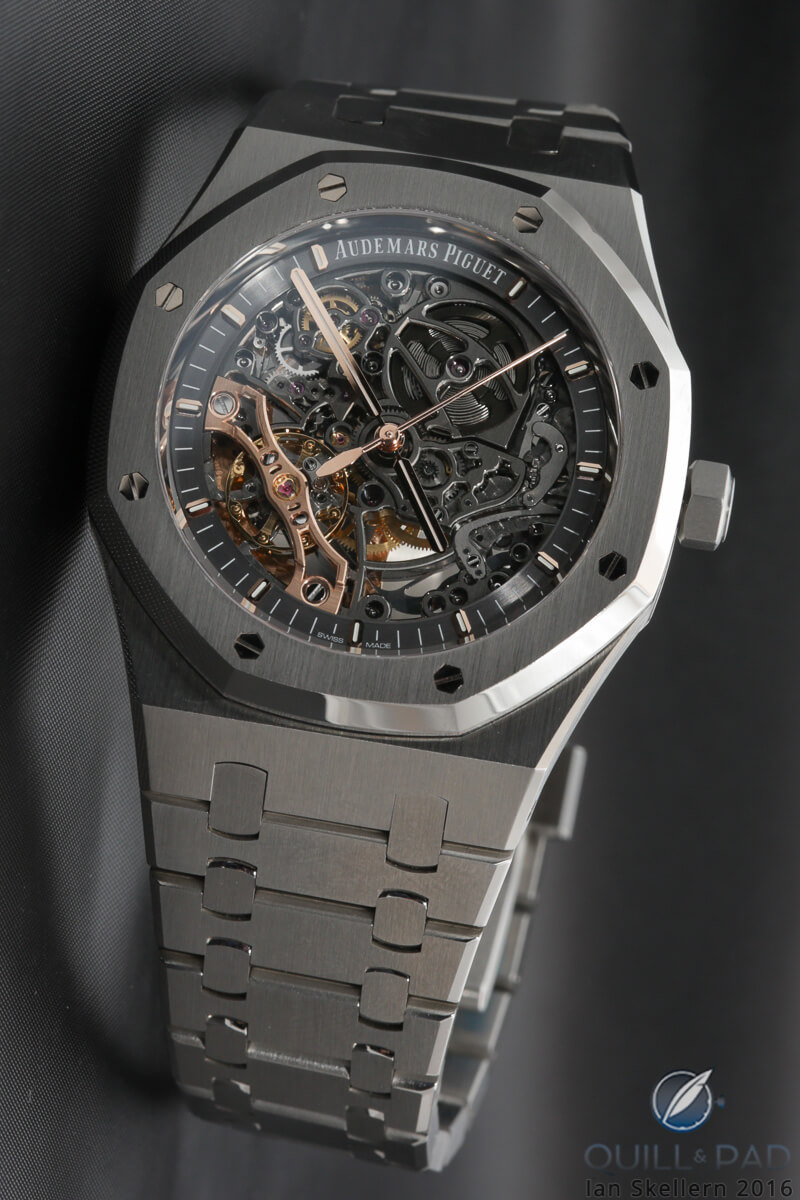
Audemars Piguet Royal Oak Double Balance Wheel Openworked in stainless steel
The layout of the movement also helps to keep you entertained as you view it. Since there is no clear pattern or design (unlike some of the flourished skeleton watches around) it means that your eye is always finding new details to enjoy instead of becoming quickly familiar and then bored with the same old thing.
And of course, it is a Royal Oak.
While a watch from this line isn’t the favorite of every WIS out there, it is probably on more Grail lists than any other watch. It has an iconic shape, and for anyone that likes well-designed objects the silhouette with the octagonal case and strong steel bracelet is a must.
As I myself have progressed as a watch enthusiast, I keep coming back to the Royal Oak as one of the better everyday watches I’ve ever seen. But since I’ve realized that mechanics interest me far more than any single watch can (what can I say? I love gears and clever levers), the Royal Oak Double Balance Openworked ticks all the boxes for a watch I could wear every day and nerd out about every night. This may be one of the best watches to come out this year.

Audemars Piguet Royal Oak Double Balance Wheel Openworked in pink gold
Who am I kidding, all the new watches are great in their own way! And this one . . . phew! It really is awesomazingly fantabulous.
So let’s break it down!
- Wowza Factor * 9.75 The openworked movement added to the double balance assembly makes for some serious horological awe!
- Late Night Lust Appeal * 92.67 » 908.78 m/s2 Who among us hasn’t lusted after some Royal Oak well into the wee hours of the morning? This one induces the same response.
- M.G.R. * 68.1 Fully skeletonized with a first-of-its-kind double balance wheel assembly, the Royal Oak Double Balance Openworked can stand tall as a mechanical marvel.
- Added-Functionitis * N/A I’m sure by this point you realize that there isn’t any need for complications when the watch is already this awesome. Because of that, there is no need for any Gotta-HAVE-That cream, even though we all want to have it!
- Ouch Outline * 10.85 Forgetting about that unsheathed knife you packed while digging through moving boxes. Yup, I just moved and, yup, I stupidly grabbed a rather sharp uncovered knife in a box of tools. I escaped with only a minor cut, but the mental surprise was much more taxing. Yet, I might still reach in that box again if I knew I might pull out this watch!
- Mermaid Moment * OMG, two balance wheels! Seriously, who wouldn’t fall head over heels for a movement with a single-staff double balance wheel like this one? All I know is that I need to get in touch with the priest to schedule him for June!
- Awesome Total * 740 Multiply the thickness of the case (a somewhat svelte 9.9 mm) with the water-resistance rating in meters (50 m), then add the number of components in the awesome movement (245) and you’ll discover the horologically radical awesome total!
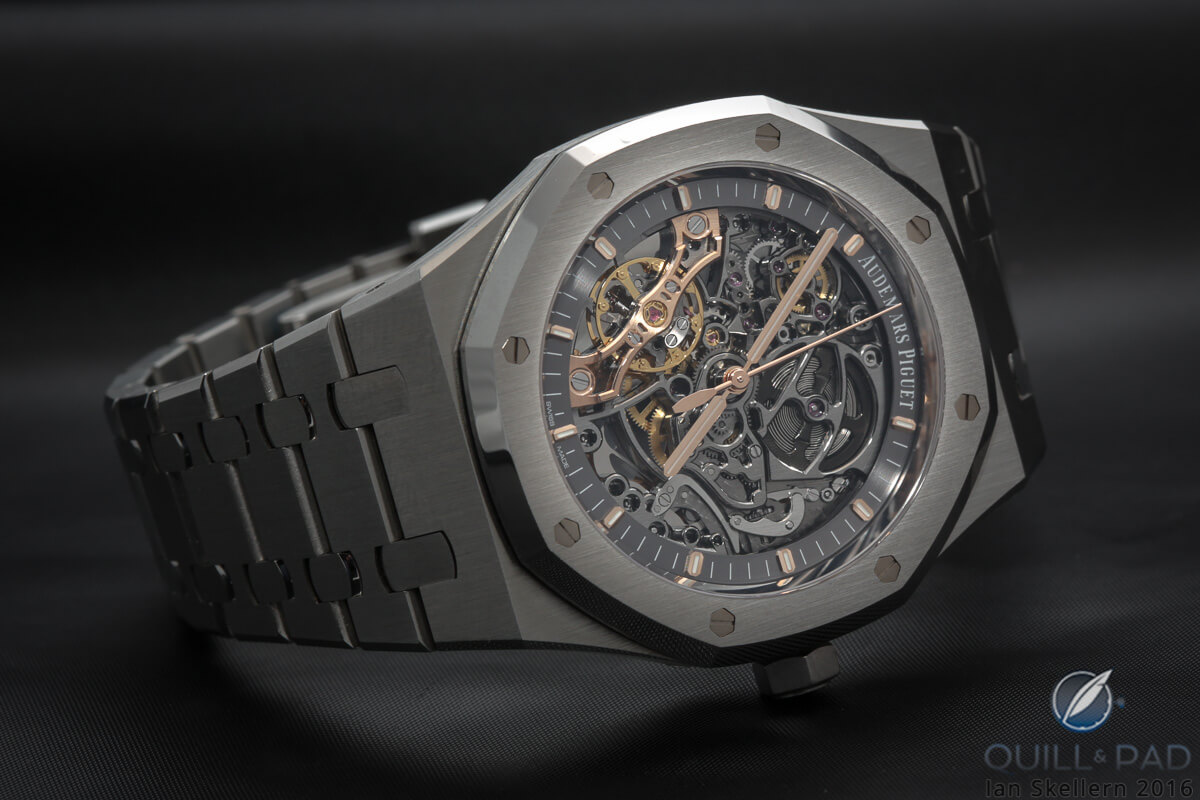
Audemars Piguet Royal Oak Double Balance Wheel Openworked in stainless steel
For more information, please visit www.audemarspiguet.com/royal-oak.
Quick Facts
Case: 41 x 9.9 mm, pink gold or stainless steel
Movement: automatic Caliber 3132, 3Hz/21,600 vph frequency, power reserve 45 hours, two balance wheels and double hairspring
Functions: hours, minutes, seconds
Price: $44,100 in steel, $76,800 in pink gold
Leave a Reply
Want to join the discussion?Feel free to contribute!





















































Such a lovely watch, and some very intriguing tech in there too!
I wonder what effect it would have on the escapement to have both balances share a single cylindrical hairspring??
Oh, thinking about it, you would have both collets rotating with eachother so it would not work one bit!
I’m not at all sure that the twin springs solve the problem of pushing the balance staff sideways increasing pivot friction. Each spring will effect the nearby pivot. Moreover, with one spring contracting while the other is unwinding, surely the tilting effect on the balance staff will be increased. I fear that, like AP’s version of the Robin Escapement, this idea has more promotional appeal than Horological wisdom.